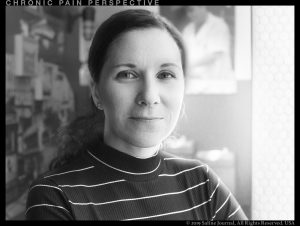
Other Voices—
From an Endometriosis survivor, advocate for awareness and support for women who are suffering, exclusive to Saline Journal. [1-3]
What a whirlwind COVID-19 has been for all of us. It is the constant conversation on every call, video conference, TV station, blog, social media post, and even simple chats with your neighbors. As I sit back and reflect on the past three weeks, which have felt like months, I am speechless. [4,5]
It is hard to think about myself and the fact that March was Endometriosis Awareness Month. [6,7]
Just three weeks ago, I had four major events planned in New York City and Detroit to help raise awareness for this chronic condition. But, at this time, society has more significant concerns. It feels wrong as an Endo advocate to say we have more significant concerns, as most people who suffer from Endo are dismissed daily; this disease lacks awareness, funding, and overall support. [8]
Typically in March, I would be spreading awareness everywhere; Endometriosis, an illness that affects one in ten Women that most people who have never heard of.
Dealing with the crisis we are in, it felt inappropriate to go all-in with awareness for Endo this year.
What does having a chronic illness like Endo have to do with COVID-19?
From a patient’s point of view, the whole world being in quarantine is how we feel most days. [9-15]
With chronic illness and chronic pain, you are unable to live the life you desire. As you are reading this, you have a much better understanding as you are most likely stuck at home wishing you could go out and do all of the things you were so lucky to have the opportunity to do just three weeks ago. [16,17]
With chronic illness, our “self-quarantine” is not always a choice and is lifelong. We live in isolation on most days and makeup excuses to miss your dinners, parties, and events. We want to attend these events, just like you want to leave the house right now; but for us, we have to choose to take care of ourselves first, or we pay the price of pain, fatigue and side effects for days if we overdo it.
We have no cure.
We don’t have an end date or light at the end of the tunnel.
We can empathize with how you feel as this is our lives most days because we don’t feel well.
There is selfish anxiety we feel. What if something happens to us, and we need medical care? We cannot see our doctors. We cannot go to the ER. We cannot get physical therapy or acupuncture. You cannot go to your favorite restaurant, bar, or cinema (Emagine, of course!). [18-22]
It is all about perspective. We are lucky we live abundant lives. I choose to see all the beautiful things I do have versus what I do not.
References
- Melissa Boudreau (home page).
- “Endometriosis” NIH: Eunice Kennedy Shriver National Institute of Child Health and Human Development, United States Department of Health and Human Services.
- “Endometriosis” Johns Hopkins Medicine.
- “Coronavirus Disease 2019 (COVID-19)” CDC: Centers for Disease Control and Prevention.
- “Novel Coronavirus Reports” CDC.
- “Endometriosis awareness 2020” Endometriosis.
- “Endometriosis Advocacy” Melissa Boudreau.
- “Use Your Words Carefully: What Is a Chronic Disease?” Stephanie Bernell and Steven W Howard (August 2, 2016) United States National Library of Medicine, National Institutes of Health (NIH).
- “Executive Order 2020-21 (COVID-19)” Governor Gretchen Whitmer (March 23, 2020) State of Michigan.
- “Analysis of financial impact on restaurants as Michigan Executive Orders 2020-09, 2020-21 remain in effect” Dell Deaton (March 23, 2020) Saline Journal.
- “Coronavirus, Social and Physical Distancing and Self-Quarantine” Lisa Lockerd Maragakis MD MPH (March 31, 2020) Johns Hopkins Medicine.
- “The risks of social isolation” Amy Novotney (May 2019) American Psychological Association.
- “The Perils of Social Isolation” Frank T McAndrew PhD (November 12, 2016) Psychology Today.
- “‘Social recession’: how isolation can affect physical and mental health” Adam Gabbatt (March 18, 2020) The Guardian.
- “‘Where Is Everybody?’ The Twilight Zone 91959-1964)” IMDb.
- “Acute versus Chronic Pain” Cleveland Clinic.
- “Chronic Pain Information Page” NIH: National Institute of Neurological Disorders and Stroke.
- “The Role of Physical Therapy in Treating Chronic Pain” Scott Dehorty (July 8, 2015) Psychology Today.
- “Manual physical therapy for chronic pain: the complex whole is greater than the sum of its parts” Rogelio A Coronado (June 12, 2017) US Library of Medicine, NIH.
- “Acupuncture is worth a try for chronic pain” Daniel Pendick (April 1, 2013) Harvard Medical School.
- “Acupuncture for chronic pain” Andrew J Vickers, D Phil, and Klaus Linde MD (March 5, 2014) US Library of Medicine, NIH.
- Emagine Entertainment (home page).
